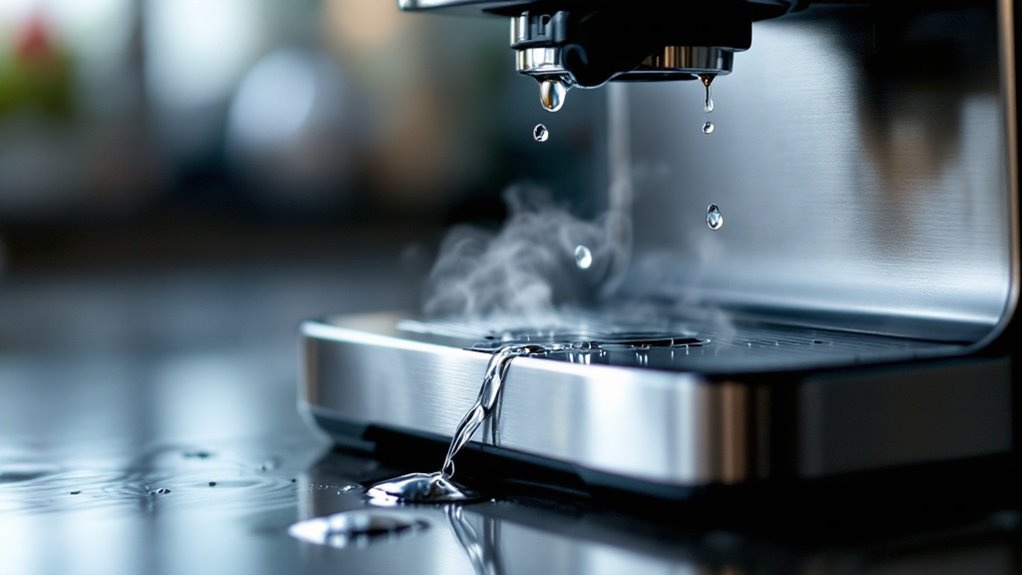



That layer of foam on your coffee isn't just a visual quirk—it's a sign of chemistry at work. When hot water meets coffee grounds, trapped carbon dioxide escapes, creating tiny bubbles that form foam. Freshly roasted beans or instant coffee particles release more gas, leading to thicker foam, but the story doesn't end there. Factors like water temperature, roast level, and even the age of your beans play a role in how much foam you'll see. What does this foam mean for your brew's flavor and freshness? The answer might change how you approach your next cup.
Key Takeaways
- Foamy coffee results from carbon dioxide gas released during brewing, especially from freshly roasted or deep-roasted beans.
- Instant coffee foam forms when trapped gas particles escape during dissolution in hot water.
- Higher water temperatures (90-96°C) enhance gas release, increasing foam intensity.
- Freshly roasted beans produce more foam due to higher carbon dioxide content.
- Stirring speed and brewing techniques, like controlled water pouring, influence foam texture and stability.
Formation of Coffee Foam
When hot water is poured over coffee grounds, it triggers the release of carbon dioxide gas trapped within the beans, leading to the formation of foam. This gas is a byproduct of the roasting process, where heat causes the decomposition of organic compounds in green coffee beans. As the beans are roasted, they develop a porous structure that traps carbon dioxide, which is then released when exposed to hot water. The foam you see consists of tiny bubbles formed by the interaction of this gas with the water and soluble compounds in the coffee grounds.
Freshly roasted beans contain more carbon dioxide, resulting in a thicker, more pronounced foam. Over time, the gas escapes naturally, so older beans produce less foam. The degree of roasting also plays a role; deep-roasted beans release more carbon dioxide, creating a more expansive foam compared to lightly roasted beans. Decaffeinated beans, however, produce less foam because the caffeine extraction process reduces their ability to retain gas. The foam's formation is a direct result of the interplay between the roasted beans, hot water, and the carbon dioxide they release.
Function of Coffee Foam
Coffee foam serves a critical role in enhancing the quality and flavor of your brew by acting as a natural filtration system. When you brew coffee, the foam forms as carbon dioxide escapes from freshly roasted coffee beans, creating a layer that traps impurities and unwanted flavors. This foam acts as a filter, preventing bitter or astringent compounds from reaching your cup, ensuring a cleaner and more balanced taste. The foam's astringent nature, which you can detect by licking it, confirms its role in absorbing undesirable elements during the brewing process. By managing the foam effectively, you optimize the extraction of desirable flavors from the coffee beans, resulting in a more authentic and enjoyable cup. The foam's presence also indicates the freshness of your coffee beans, as it forms more prominently when beans are recently roasted. Understanding this function helps you appreciate how foam contributes to the overall flavor profile, making it an essential component of the brewing process.
Freshness and Foam Expansion
Freshly roasted coffee beans, rich in carbon dioxide, drive foam expansion during brewing, creating a visible indicator of bean freshness. When you brew coffee, the carbon dioxide trapped in roasted beans escapes, forming bubbles that contribute to foam. Deep-roasted beans, which undergo longer roasting, retain more carbon dioxide and produce a thicker, more pronounced foam compared to shallow-roasted beans. The latter, roasted for shorter durations, contain less gas and yield minimal foam expansion.
Freshness plays a critical role in foam formation. Beans a few days post-roast strike a balance, releasing enough carbon dioxide for foam without compromising flavor. Overly fresh beans, however, can release excessive gas, leading to overly foamy but bland coffee. Decaffeinated beans, due to the removal of caffeine and reduced gas retention, produce considerably less foam, regardless of roast level.
The foam expansion you observe directly correlates with the carbon dioxide content, which diminishes as beans age. Deep-roasted beans, with their higher gas retention, offer a more reliable freshness indicator through foam. By observing foam expansion, you can gauge the freshness of your roasted beans and adjust your brewing process accordingly.
Tips for Brewing Fluffy Coffee Foam
How can you achieve consistently fluffy coffee foam? Start by selecting deep-roasted beans, which retain more carbon dioxide, enhancing foam formation. Make certain your beans are freshly roasted but aged 7-10 days to stabilize the foam. When brewing, pour hot water in 3-4 stages, maintaining a temperature of 90-96°C (195-205°F). This technique prevents over-extraction and encourages even gas release, resulting in a creamy, stable foam layer. For instant coffee, the Dalgona method requires vigorous whisking in a metal bowl to create small, uniform bubbles. Use medium-speed mixing to avoid frothy, unstable foam. If you prefer the normal method, grind your beans finely and brew with precision, making sure the water-to-coffee ratio is balanced. The metal bowl aids in heat retention, which is vital for maintaining foam consistency. Avoid shallow-roasted beans, as they lack the necessary carbon dioxide for rich foam. By combining these techniques—pouring hot water strategically, using deep-roasted beans, and employing the right tools—you'll achieve a velvety, long-lasting foam every time.
Importance of Roasting and Brewing Techniques
The quality of your coffee foam hinges on the interplay between roasting and brewing techniques. Roasting duration and temperature directly influence carbon dioxide retention in the beans. Deeper roasts release more gas, creating greater foam expansion, while shallow-roasted beans produce less foam due to reduced carbon dioxide content. For ideal foam and flavor, use beans a few days after roasting; freshly roasted beans release excessive carbon dioxide, which can result in bland coffee.
Brewing techniques also play a critical role. Controlled water pouring and dividing hot water into portions enhance foam quality and flavor clarity. Lower water temperatures during brewing reduce carbon dioxide release, preserving the coffee's flavor while still allowing for foam formation. By balancing these factors—roasting depth, bean freshness, and precise brewing—you can achieve a rich, stable foam that complements the coffee's flavor profile. Mastering these techniques guarantees that your foam isn't just visually appealing but also enhances the overall sensory experience of your coffee.
Foaming Mechanism in Instant Coffee
When you stir instant coffee, you release trapped gas particles that were encapsulated during its production process. These gases, remnants of freeze-drying or spray-drying, form a temporary foam as they escape into the air. The foam dissipates quickly because the gas particles aren't stabilized by oils or proteins, unlike in espresso crema.
Gas Release During Stirring
You might notice that your instant coffee foams up when you stir it, and this happens because trapped gas particles, leftover from the production process, are released. When you add hot water to instant coffee, the heat increases the energy of these trapped gases, causing them to expand and escape more readily. As you stir, the agitation disrupts the structure of the coffee granules, allowing the gas particles to break free and rise to the surface. This release creates the foaming effect you observe. The foam is temporary, as the gases dissipate quickly into the air, unlike the stable crema in espresso. The process is purely physical; no chemical reactions or heat from dissolution contribute to the foaming. Once the gases have fully escaped, the foam cannot be recreated, even with additional stirring. The combination of hot water and stirring accelerates the release of trapped gases, making the foaming more pronounced. This mechanism is a direct result of the production process, which leaves microscopic gas pockets within the instant coffee granules.
Production Process Impact
Foaming in instant coffee is directly tied to its production process, specifically the methods of freeze-drying or spray-drying used to create the granules. During freeze-drying, brewed coffee is frozen and then dehydrated under vacuum, leaving behind porous granules that trap gas particles. Spray-drying involves atomizing liquid coffee into a hot chamber, forming fine particles that also retain gas. These trapped gases, remnants of the production process, are released when you dissolve the instant coffee in hot water, creating the foam you observe. The heat accelerates the escape of gas particles, enhancing the foaming effect. However, this foam dissipates quickly because the gases escape rapidly, unlike the stable crema in espresso. The foaming isn't caused by a chemical reaction or heat from dissolution; it's purely a mechanical release of gases trapped during production. While foaming isn't an intentional feature of instant coffee, it's an inevitable byproduct of the freeze-drying or spray-drying methods. Understanding this process clarifies why your cup of instant coffee foams and why the effect is temporary.
Comparison With Regular Coffee Grounds
Comparing regular coffee grounds to instant coffee reveals distinct differences in how foam forms during brewing. Regular coffee grounds release CO2 during the brewing process, a natural degassing phenomenon that creates a stable, persistent foam known as the "bloom." This foam is often used as an indicator of freshness, as fresher grounds release more CO2. In contrast, instant coffee produces foam from gas particles trapped during its manufacturing process, such as freeze-drying or spray-drying. This foam is less stable and dissipates quickly, lacking the structural integrity of the bloom in regular coffee.
The foam in regular coffee grounds is influenced by factors like roast level and freshness, while instant coffee foam is a byproduct of its production and unrelated to freshness. The CO2 release in regular coffee grounds creates a more complex and aromatic foam, whereas instant coffee foam is primarily a surface-level effect. Understanding these differences helps you appreciate why your coffee foams differently depending on whether you use regular coffee grounds or instant coffee.
Factors Influencing Foaming
The formation of foam in coffee is influenced by several key factors, each contributing to the texture, stability, and intensity of the bubbles. Carbon dioxide content plays a critical role, as freshly roasted beans with higher gas levels produce more foam during brewing. Darker roasts, in particular, release more gas, leading to greater foam expansion compared to lighter roasts. Water temperature also substantially impacts foam formation; hotter water enhances gas release, creating a more intense and stable foam. Conversely, cooler water may result in weaker foam with larger, less consistent bubbles. Stirring speed and technique further influence foam texture, with slower, gentler mixing producing smaller, creamier bubbles, while rapid stirring can lead to larger, less stable foam. Additionally, decaffeinated beans tend to produce less foam due to reduced gas retention during processing. By understanding these factors—carbon dioxide content, darker roasts, water temperature, and stirring speed—you can better control the foam texture and stability in your coffee.
Practical Observations and Applications
When preparing coffee, you'll notice that foaming often occurs during brewing, particularly with instant coffee, as gas escapes from the dissolved particles. This gas release is a natural process, driven by the breakdown of volatile compounds trapped during production. Higher water temperatures accelerate this reaction, intensifying foam formation and making it more visible. However, the foam dissipates quickly, leaving no residue and having no impact on the coffee's flavor or quality.
Foaming serves as a practical indicator of coffee freshness and production quality. Fresh instant coffee typically exhibits more pronounced foaming due to higher gas content, while older or improperly stored coffee may show reduced foam formation. By observing the foam, you can gauge the gas release and assess the product's condition.
To optimize foam formation, use water heated to around 90-95°C (194-203°F). This temperature range maximizes gas release without scalding the coffee. Once the gas escapes, the foam cannot be recreated, so timing is critical. These observations not only enhance your brewing experience but also provide insights into the coffee's production quality and shelf life.
Disclosure: As an Amazon Associate, I earn from qualifying purchases.







